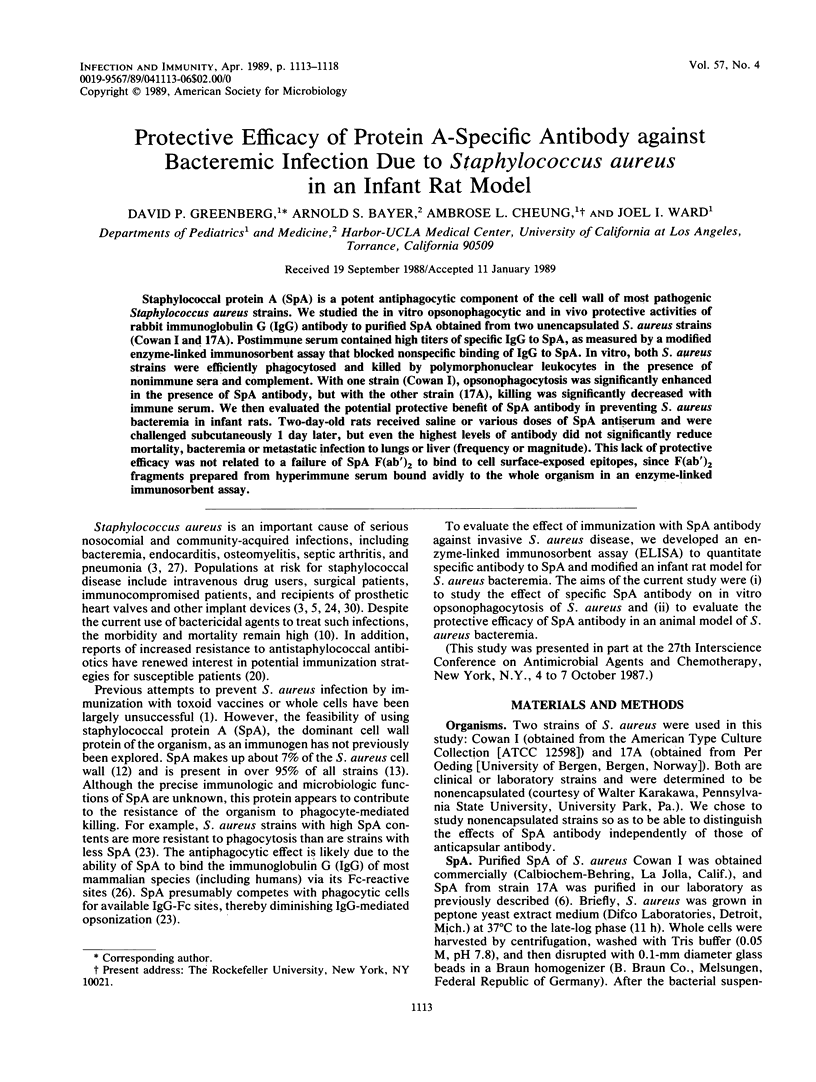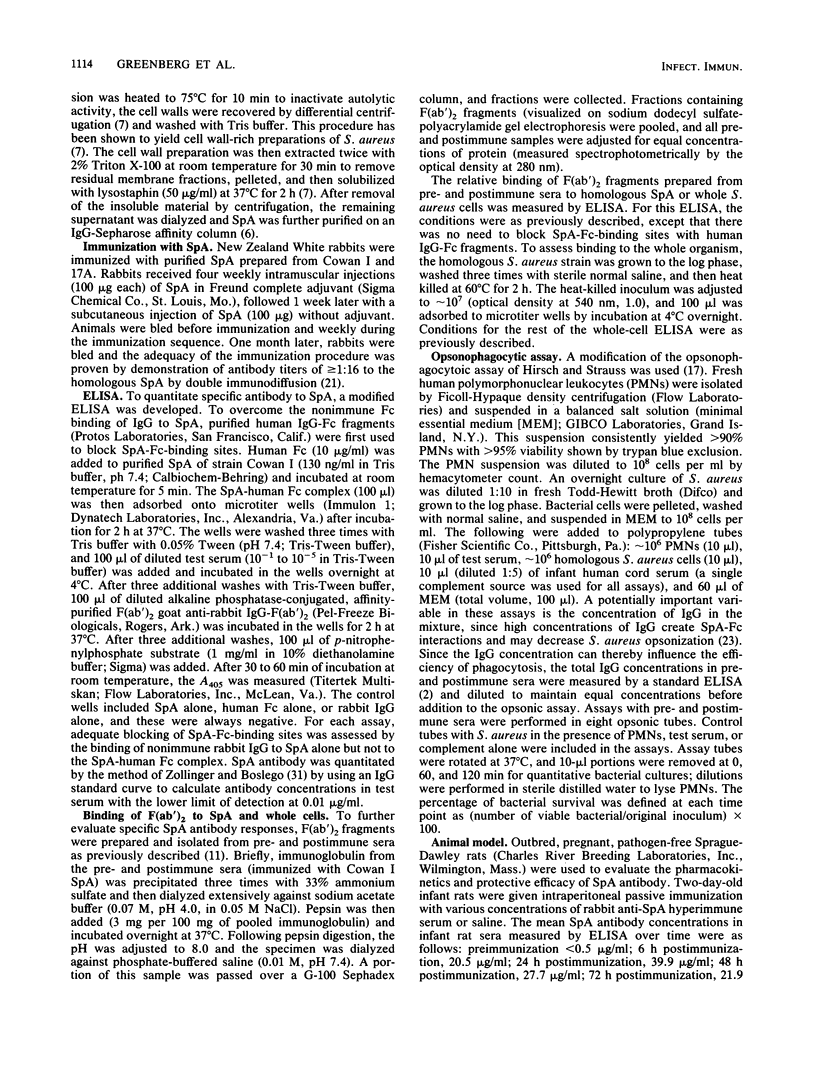Abstract
Staphylococcal protein A (SpA) is a potent antiphagocytic component of the cell wall of most pathogenic Staphylococcus aureus strains. We studied the in vitro opsonophagocytic and in vivo protective activities of rabbit immunoglobulin G (IgG) antibody to purified SpA obtained from two unencapsulated S. aureus strains (Cowan I and 17A). Postimmune serum contained high titers of specific IgG to SpA, as measured by a modified enzyme-linked immunosorbent assay that blocked nonspecific binding of IgG to SpA. In vitro, both S. aureus strains were efficiently phagocytosed and killed by polymorphonuclear leukocytes in the presence of nonimmune sera and complement. With one strain (Cowan I), opsonophagocytosis was significantly enhanced in the presence of SpA antibody, but with the other strain (17A), killing was significantly decreased with immune serum. We then evaluated the potential protective benefit of SpA antibody in preventing S. aureus bacteremia in infant rats. Two-day-old rats received saline or various doses of SpA antiserum and were challenged subcutaneously 1 day later, but even the highest levels of antibody did not significantly reduce mortality, bacteremia or metastatic infection to lungs or liver (frequency or magnitude). This lack of protective efficacy was not related to a failure of SpA F(ab')2 to bind to cell surface-exposed epitopes, since F(ab')2 fragments prepared from hyperimmune serum bound avidly to the whole organism in an enzyme-linked immunosorbent assay.
Full text
PDF





Selected References
These references are in PubMed. This may not be the complete list of references from this article.
- Anthony B. F., Concepcion N. F., Concepcion K. F. Human antibody to the group-specific polysaccharide of group B Streptococcus. J Infect Dis. 1985 Feb;151(2):221–226. doi: 10.1093/infdis/151.2.221. [DOI] [PubMed] [Google Scholar]
- Bayer A. S. Staphylococcal bacteremia and endocarditis: state of the art. Arch Intern Med. 1982 Jun;142(6):1169–1177. [PubMed] [Google Scholar]
- Bayer A. S., Tillman D. B., Concepcion N., Guze L. B. Clinical value of teichoic acid antibody titers in the diagnosis and management of the staphylococcemias. West J Med. 1980 Apr;132(4):294–300. [PMC free article] [PubMed] [Google Scholar]
- Chambers H. F., Korzeniowski O. M., Sande M. A. Staphylococcus aureus endocarditis: clinical manifestations in addicts and nonaddicts. Medicine (Baltimore) 1983 May;62(3):170–177. [PubMed] [Google Scholar]
- Cheung A. L., Bayer A. S., Peter J., Ward J. I. Surface proteins of Staphylococcus aureus. Rev Infect Dis. 1988 Jul-Aug;10 (Suppl 2):S351–S355. doi: 10.1093/cid/10.supplement_2.s351. [DOI] [PubMed] [Google Scholar]
- Cheung A. L., Bayer A. S., Peters J., Ward J. I. Analysis by gel electrophoresis, Western blot, and peptide mapping of protein A heterogeneity in Staphylococcus aureus strains. Infect Immun. 1987 Apr;55(4):843–847. doi: 10.1128/iai.55.4.843-847.1987. [DOI] [PMC free article] [PubMed] [Google Scholar]
- DERBY B. M., ROGERS D. E. Studies on bacteriemia. V. The effect of simultaneous leukopenia and reticuloendothelial blockade on the early blood stream clearance of staphylococci and Escherichia coli. J Exp Med. 1961 Jun 1;113:1053–1066. doi: 10.1084/jem.113.6.1053. [DOI] [PMC free article] [PubMed] [Google Scholar]
- Dossett J. H., Kronvall G., Williams R. C., Jr, Quie P. G. Antiphagocytic effects of staphylococcal protein A. J Immunol. 1969 Dec;103(6):1405–1410. [PubMed] [Google Scholar]
- Espersen F., Frimodt-Møller N. Staphylococcus aureus endocarditis. A review of 119 cases. Arch Intern Med. 1986 Jun;146(6):1118–1121. [PubMed] [Google Scholar]
- Forsgren A. Protein A from Staphylococcus aureus. 8. Production of protein A by bacterial and L-forms of S. aureus. Acta Pathol Microbiol Scand. 1969;75(3):481–490. [PubMed] [Google Scholar]
- Forsgren A. Significance of protein a production by staphylococci. Infect Immun. 1970 Nov;2(5):672–673. doi: 10.1128/iai.2.5.672-673.1970. [DOI] [PMC free article] [PubMed] [Google Scholar]
- Granström M., Julander I., Möllby R. Serological diagnosis of deep Staphylococcus aureus infections by enzyme-linked immunosorbent assay (ELISA) for staphylococcal hemolysins and teichoic acid. Scand J Infect Dis Suppl. 1983;41:132–139. [PubMed] [Google Scholar]
- Greenberg D. P., Ward J. I., Bayer A. S. Influence of Staphylococcus aureus antibody on experimental endocarditis in rabbits. Infect Immun. 1987 Dec;55(12):3030–3034. doi: 10.1128/iai.55.12.3030-3034.1987. [DOI] [PMC free article] [PubMed] [Google Scholar]
- HIRSCH J. G., STRAUSS B. STUDIES ON HEAT-LABILE OPSONIN IN RABBIT SERUM. J Immunol. 1964 Jan;92:145–154. [PubMed] [Google Scholar]
- Kronvall G., Quie P. G., Williams R. C., Jr Quantitation of staphylococcal protein A: Determination of equilibrium constant and number of protein A residues on bacteria. J Immunol. 1970 Feb;104(2):273–278. [PubMed] [Google Scholar]
- Myers J. P., Linnemann C. C., Jr Bacteremia due to methicillin-resistant Staphylococcus aureus. J Infect Dis. 1982 Apr;145(4):532–536. doi: 10.1093/infdis/145.4.532. [DOI] [PubMed] [Google Scholar]
- Pankey J. W., Boddie N. T., Watts J. L., Nickerson S. C. Evaluation of protein A and a commercial bacterin as vaccines against Staphylococcus aureus mastitis by experimental challenge. J Dairy Sci. 1985 Mar;68(3):726–731. doi: 10.3168/jds.S0022-0302(85)80879-1. [DOI] [PubMed] [Google Scholar]
- Peterson P. K., Verhoef J., Sabath L. D., Quie P. G. Effect of protein A on staphylococcal opsonization. Infect Immun. 1977 Mar;15(3):760–764. doi: 10.1128/iai.15.3.760-764.1977. [DOI] [PMC free article] [PubMed] [Google Scholar]
- Rice P. A., Vayo H. E., Tam M. R., Blake M. S. Immunoglobulin G antibodies directed against protein III block killing of serum-resistant Neisseria gonorrhoeae by immune serum. J Exp Med. 1986 Nov 1;164(5):1735–1748. doi: 10.1084/jem.164.5.1735. [DOI] [PMC free article] [PubMed] [Google Scholar]
- Richman D. D., Cleveland P. H., Oxman M. N., Johnson K. M. The binding of staphylococcal protein A by the sera of different animal species. J Immunol. 1982 May;128(5):2300–2305. [PubMed] [Google Scholar]
- Sheagren J. N. Staphylococcus aureus. The persistent pathogen (first of two parts). N Engl J Med. 1984 May 24;310(21):1368–1373. doi: 10.1056/NEJM198405243102107. [DOI] [PubMed] [Google Scholar]
- Sjöquist J., Stålenheim G. Protein A from Staphylococcus aureus. IX. Complement-fixing activity of protein A-IgG complexes. J Immunol. 1969 Sep;103(3):467–473. [PubMed] [Google Scholar]
- Verbrugh H. A., Peters R., Rozenberg-Arska M., Peterson P. K., Verhoef J. Antibodies to cell wall peptidoglycan of Staphylococcus aureus in patients with serious staphylococcal infections. J Infect Dis. 1981 Jul;144(1):1–9. doi: 10.1093/infdis/144.1.1. [DOI] [PubMed] [Google Scholar]
- Wilson W. R., Jaumin P. M., Danielson G. K., Giuliani E. R., Washington JA I. I., Geraci J. E. Prosthetic valve endocarditis. Ann Intern Med. 1975 Jun;82(6):751–756. doi: 10.7326/0003-4819-82-6-751. [DOI] [PubMed] [Google Scholar]
- Zollinger W. D., Boslego J. W. A general approach to standardization of the solid-phase radioimmunoassay for quantitation of class-specific antibodies. J Immunol Methods. 1981;46(2):129–140. doi: 10.1016/0022-1759(81)90130-7. [DOI] [PubMed] [Google Scholar]


